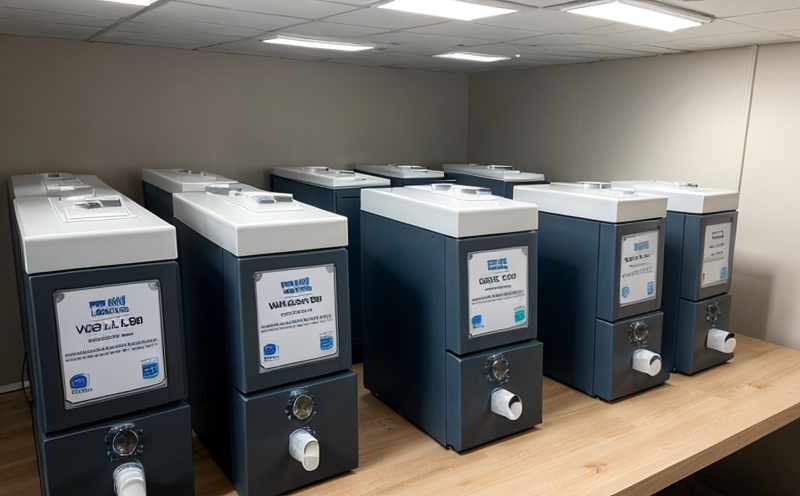ASTM D6196 Sampling and analysis of VOCs using sorbent tubes and GC MS
The ASTM D6196 standard method is a widely recognized protocol used for the sampling and quantitative analysis of volatile organic compounds (VOCs) in air. This method employs sorbent tubes to capture VOCs from ambient or process air, followed by thermal desorption into a gas chromatograph–mass spectrometer (GC-MS). The GC-MS then separates and identifies the various compounds present in the sample.
Formaldehyde is one of the most common VOCs tested using this method. It can be found in textiles, paints, adhesives, and other building materials, making it a critical parameter for indoor air quality (IAQ) assessments. The standard requires that samples are collected over a specific period to ensure an accurate representation of the environment being analyzed.
The sampling duration is typically 15 minutes, but this can vary depending on the nature of the emission source. After sampling, the sorbent tube is sealed and transported to the laboratory for analysis. At Eurolab, we use high-performance GC-MS instruments that comply with international standards such as ISO/IEC 17025. Our analysts have extensive experience in handling VOC samples and interpreting results according to ASTM D6196.
The detection limit for formaldehyde using this method is approximately 0.01 ppm, making it suitable for detecting even trace amounts of this compound. The method also allows for the simultaneous analysis of multiple VOCs, providing a comprehensive overview of air quality in any given environment.
Our laboratory adheres strictly to ASTM D6196 guidelines during both sampling and analysis phases. This ensures that our results are accurate, reliable, and comparable with other laboratories around the world. We use calibrated sampling devices and sorbent tubes from reputable manufacturers to guarantee consistent performance across all samples.
In addition to formaldehyde, this method can be applied to a wide range of VOCs including benzene, toluene, xylenes, ethylbenzene, and other aromatic hydrocarbons. The ability to analyze these compounds makes ASTM D6196 an essential tool for industries such as textiles, furniture manufacturing, and construction.
The analysis results are presented in a detailed report that includes the concentration levels of each detected VOC, along with any necessary recommendations based on local or international standards like OSHA, EPA, and WHO guidelines. Our reports are designed to be easily understood by quality managers, compliance officers, R&D engineers, and procurement personnel who need clear insights into the air quality in their facilities.
By using ASTM D6196 for VOC analysis, companies can ensure they meet regulatory requirements while also improving their overall environmental performance. This method helps identify potential sources of indoor pollution early on, allowing for proactive measures to be taken before issues become critical.
Benefits
The use of ASTM D6196 offers several key benefits:
- Precision and Accuracy: Our laboratory ensures that every sample is handled with care, following strict procedures outlined in the standard. This guarantees precise measurements and accurate results.
- Compliance Assurance: By adhering to ASTM D6196, businesses can be confident they are meeting regulatory requirements for VOC emissions in their products or facilities.
- Environmental Protection: Early detection of VOCs allows companies to address potential issues promptly, reducing harm to both human health and the environment.
- Data Reliability: Consistent sampling techniques and advanced GC-MS technology provide reliable data that can be used for trend analysis over time.
- Cost Efficiency: Identifying problems early through regular VOC testing can prevent larger, more costly issues down the line.
- Informed Decision Making: With detailed reports based on ASTM D6196 results, decision-makers have access to valuable information that aids in strategic planning and implementation of improvements.
In summary, adopting ASTM D6196 for VOC analysis not only enhances compliance but also supports sustainable practices within organizations. It provides a robust foundation for maintaining high-quality standards across various sectors including textiles, furniture manufacturing, and construction.
Eurolab Advantages
At Eurolab, we pride ourselves on offering superior service and expertise when it comes to ASTM D6196 sampling and analysis. Here are some of the advantages that set us apart:
- Certified Experts: Our team consists of highly qualified professionals who have extensive experience in performing ASTM D6196 tests.
- State-of-the-Art Facilities: We operate cutting-edge laboratories equipped with the latest technology, including high-performance GC-MS instruments that meet stringent quality control standards.
- Comprehensive Reporting: Our reports go beyond mere numbers; they provide actionable insights backed by comprehensive data analysis.
- Rapid Turnaround Times: We understand the importance of timely results and strive to deliver them swiftly without compromising accuracy or integrity.
- Custom Solutions: Whether you need routine testing or one-off assessments, we offer flexible options tailored specifically to your needs.
- Customer Support: Our dedicated customer support team is always available to assist with any queries or concerns related to ASTM D6196 services.
We are committed to delivering excellence in every aspect of our service. Contact us today to learn more about how Eurolab can help you meet your VOC testing requirements effectively and efficiently.
Environmental and Sustainability Contributions
The analysis of VOCs using ASTM D6196 plays a crucial role in promoting environmental sustainability. By identifying potential sources of indoor air pollution early on, businesses can take proactive steps to mitigate their impact on public health and the environment.
Textile manufacturing is just one example where this method proves invaluable. Textiles often contain significant amounts of formaldehyde due to its use as a finishing agent during processing. Regular VOC testing helps manufacturers monitor emissions levels and adjust production processes accordingly, ensuring compliance with both local regulations and international best practices.
Beyond mere compliance, adopting ASTM D6196 supports broader sustainability goals by encouraging responsible resource management throughout the supply chain. For instance, by reducing unnecessary waste or improving energy efficiency through better ventilation systems, companies contribute positively towards global efforts aimed at combating climate change.
In conclusion, implementing ASTM D6196 sampling and analysis is not only beneficial for individual organizations but also contributes significantly to broader environmental sustainability initiatives worldwide. At Eurolab, we are dedicated to supporting these efforts through our commitment to excellence in testing services.





